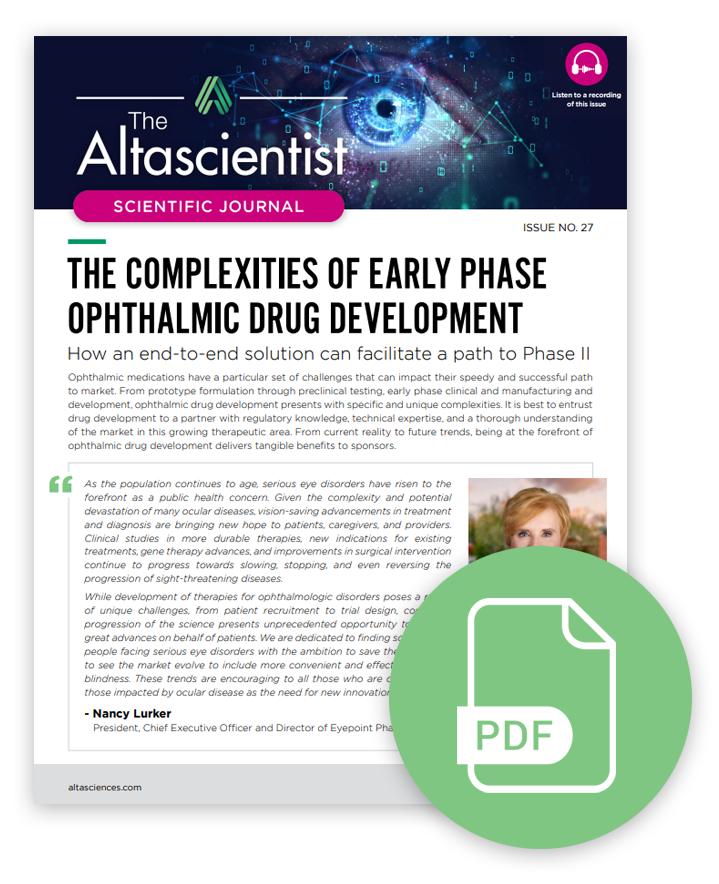Manufacturing and Analytical Services
Case Study―Evaluating Milling Conditions for Scaling Up a Nanosuspension Drug Product
Ophthalmic End-to-End Drug Development Solutions
Six Reasons to Choose Altasciences as Your CDMO Partner
Whether you are embarking on Preclinical safety testing, Phase I clinical trials, or need manufacturing services f
ISSUE NO. 28 — Applications of Liquid-Filled Hard-Shell Capsules in Drug Development

Liquid-filled hard-shell capsules (LFHCs) are a popular formulation for oral solid delivery of chemical drugs and nutraceuticals. Often selected for drugs with poor solubility/bioavailability, LFHCs also have applications in a number of other situations, including specific benefits during early-phase clinical development.
In Issue 28 of The Altascientist, you will find:
• Applications of LFHCs
• The production process
• The role of excipients
• Other advantages of LFHCs
• A case study
• How Altasciences can help
Applications for Liquid-Filled Hard-Shell Capsules in Your Drug Development Program
The use of modern drug discovery approaches, such as combinatorial chemistry and high-throughput screening, as well as structural understanding of drug-target binding by X-ray diffraction and molecular modelling, has resulted in an increasing percentage of highly potent lead compounds.
The majority of these compounds have high-melting points and poor aqueous solubility, which directly impact their dissolution and bioavailability. In an LFHC, readily metabolized lipid-based solutions are used as liquid carriers, providing for optimized absorption of the active pharmaceutical ingredient (API).
LFHCs offer several advantages for handling these challenging APIs, including:
• improved safety in processing and administration of potent drugs
• ease of administration
• flexible application
• abuse-resistant formulations
How Altasciences Can Help With Your Liquid-Filled Hard-Shell Capsule Formulations and Manufacturing
Altasciences has a proven track record and thorough expertise with LFHCs, having completed numerous projects over the years, for a wide range of clients. Our highly knowledgeable experts will assist you in determining the most appropriate and efficient program parameters, from batch size to excipient selection and capsule composition, color, and banding options. Our skilled operators use state-of-the-art machinery for every step of the process. We perform comprehensive process validation prior to manufacture, identifying and correcting any potential issue before it becomes a problem. We provide 100% manual inspection of the finished capsules and take pride in doing the job right the first time, every time.
Explore all issues of The Altascientist in our Resource Center. And don’t forget to subscribe to “The Altascientist: Audiobooks” on Spotify, Apple Podcasts, or wherever you get your audio content.
Case Study―Product Manufacturing and Analytical Testing for an Ocular Client
ISSUE NO. 27 — The Complexities of Early-Phase Ophthalmic Drug Development

Ophthalmic medications have a particular set of challenges that can impact their speedy and successful path to market. From prototype formulation through preclinical testing, early-phase clinical and manufacturing and development, ophthalmic drug development presents with specific and unique complexities. It is best to entrust drug development to a partner with regulatory knowledge, technical expertise, and a thorough understanding of the market in this growing therapeutic area. From current reality to future trends, being at the forefront of ophthalmic drug development delivers tangible benefits to sponsors.
In Issue 27 of The Altascientist, we dive into all areas of ophthalmic drug development, including:
• Prototype development, formulation, and manufacturing
• Preparing for first-in-human studies
• Species and strain selection parameters
• Routes of administration
• Specialized ocular assessments and equipment
• bioanalysis
• Phase I clinical research
• Phase II to commercialization
Three case studies are also included!
Navigating the Complexities of Ophthalmic Drug Development
The global market for ophthalmic drugs was valued at USD 36.7 billion in 2020, according to Grandview Research. The compound annual growth rate (CAGR) is expected to be 6.4% from 2021 to 2028. The acceleration in market growth is influenced by increasing awareness of eye-related diseases and advancements in related technology. The aging of the population, as well as the impact of COVID-19 ocular involvement, are also contributing factors. Certain ocular diseases are quite rare, whereas others, such as cataracts, age-related macular degeneration (AMD), and glaucoma, are very common, especially in the aging population.
Drug development in the ocular space has specific challenges. The eye is a multi-faceted organism and has many barriers to drug delivery. Formulation and delivery options must be expertly planned and developed to overcome those barriers and ensure that the maximum bioavailability is achieved without negatively impacting vision or the physical structure of the eye. Planning of preclinical studies must consider the appropriate animal species for the route of administration and therapeutic area of the investigational drug. Some species are more appropriate for certain routes of administration, while others have relevant retinal mutations that can be leveraged in ocular development.
Clinical trials need to be carefully designed by knowledgeable specialists with significant ophthalmic experience. The delicate nature of the eye and the importance of subject safety are key considerations. Just as importantly, the bioanalysis of trial samples necessitates the use of bioanalytical techniques created especially for the often uncommon and frequently fragile matrices involved. Finally, understanding the regulatory environment and related guidances, as well as proactive and appropriate discussions with relevant agencies when warranted, are critical components of the pathway and can help ensure a seamless experience.
Explore all issues of The Altascientist in our Resource Center. And don’t forget to subscribe to “The Altascientist: Audiobooks” on Spotify, Apple Podcasts, or wherever you get your audio content.
Download publicationTest Your Knowledge of Liquid-Filled Capsules
Thanks to updated screening methods and bioavailability enhancements, poorly soluble molecules comprise 70% to 80% of the small molecule products entering the drug development pipeline today. Since poorly soluble drugs are difficult to formulate as tablets, formulation scientists are looking to two-piece, liquid-filled hard-shell capsules as a solution.
Rapid Development of a Liquid-filled, Hard-Shell Capsule Formulation of Cannabidiol
The Advantages of Liquid-Filled Capsules Over Tablets in All Phases of Drug Development
One Integrated Solution for Meeting Your Preclinical to Clinical Drug Development Needs